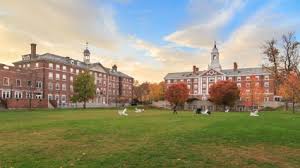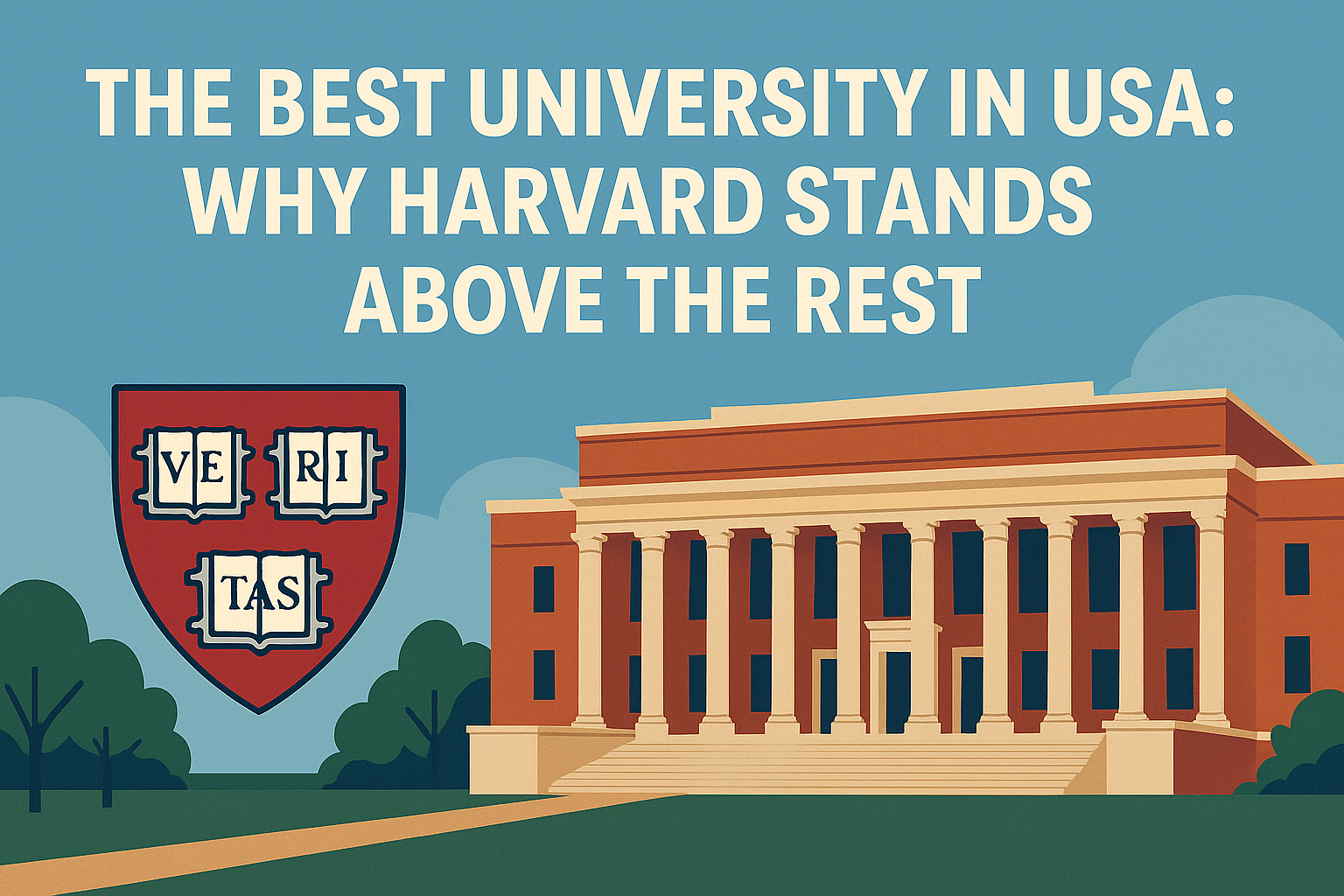The Best University in the USA: Why Harvard Stands Above the Rest
When it comes to higher education, the United States is home to many of the world’s most prestigious universities. Institutions like Stanford, MIT, Princeton, and Yale frequently top global rankings and produce leaders in every field imaginable. But among this elite group, one name often rises to the very top: Harvard University. Founded in 1636, Harvard is the oldest institution of higher learning in the United States and is widely regarded as the best university in the country—and arguably, the world.
This article explores why Harvard maintains this esteemed position, examining its academic excellence, faculty, research, alumni network, resources, and impact on society.

A Legacy of Excellence
Harvard’s reputation is built on centuries of tradition, academic rigor, and a relentless pursuit of knowledge. Located in Cambridge, Massachusetts, it is one of the eight Ivy League schools and has been a symbol of excellence in education for nearly 400 years. Over time, Harvard has evolved from a small college for Puritan clergy into a global educational powerhouse with over 20,000 students and a multi-billion-dollar endowment.
What sets Harvard apart is not only its long history but its consistent performance across multiple disciplines. Whether it’s the arts, humanities, sciences, law, business, or medicine, Harvard has made lasting contributions to nearly every field.
Academic Excellence
One of the primary factors that solidify Harvard’s position as the best university is its unparalleled academic rigor and diversity of programs. Harvard offers more than 50 undergraduate concentrations and over 130 graduate programs through its various schools, including:
- Harvard College (Undergraduate)
- Harvard Business School
- Harvard Law School
- Harvard Medical School
- Harvard Kennedy School (Public Policy)
- Harvard Graduate School of Education
The university employs a world-renowned faculty, including Nobel laureates, Pulitzer Prize winners, and former world leaders. With a student-faculty ratio of 7:1, Harvard ensures that students receive personalized attention and mentorship from some of the most accomplished minds in the world.
Research and Innovation
Harvard is a global leader in research. Its faculty and students conduct groundbreaking work across all fields, from quantum physics and biomedical engineering to philosophy and political science. The university’s research output is among the highest in the world, supported by billions of dollars in funding each year.
For instance, Harvard Medical School is at the forefront of health sciences, frequently contributing to medical breakthroughs. Similarly, the university’s School of Engineering and Applied Sciences (SEAS) is pushing the boundaries in artificial intelligence, robotics, and environmental science.
The Harvard Library system—one of the largest academic library systems in the world—contains over 20 million volumes, providing a foundation for academic inquiry and research unlike any other.
Global Impact and Alumni Network
Another reason Harvard is considered the best university in the U.S. is its incredible global influence and alumni network. Its alumni include:
- 8 U.S. Presidents (including John F. Kennedy and Barack Obama)
- Over 160 Nobel laureates
- 14 Turing Award winners
- Dozens of heads of state, CEOs, and thought leaders
Harvard graduates are found at the highest levels of every major field, including politics, business, science, and the arts. This expansive network provides students with unparalleled opportunities for mentorship, internships, and job placement. The “Harvard name” on a résumé often opens doors worldwide.
Financial Aid and Accessibility
Despite its reputation for exclusivity, Harvard has made significant strides in increasing access and affordability. The university offers a generous need-based financial aid program, ensuring that admission is based on merit and not the ability to pay. Over 55% of undergraduates receive financial aid, and families earning under $85,000 per year typically pay nothing for tuition, room, or board.
This commitment to equity makes Harvard more accessible than many other top-tier universities. By leveling the playing field, Harvard attracts a diverse, talented student body from all socioeconomic backgrounds.
Campus Life and Student Experience
The Harvard student experience is a unique blend of academic rigor and vibrant extracurricular life. Students have access to:
- Over 450 student organizations, including The Harvard Crimson (student newspaper), debate societies, cultural clubs, and more
- World-class athletic facilities and NCAA Division I sports teams
- Study abroad programs and global fellowships
- Lectures and events featuring global leaders, authors, and innovators
Living in Cambridge also provides access to the rich cultural and academic ecosystem of the Boston metropolitan area, home to MIT, Tufts, and dozens of other higher education institutions.
Diversity and Inclusion
In recent years, Harvard has made meaningful efforts to improve diversity and inclusion across its campus. It has implemented initiatives to support first-generation college students, expand faculty diversity, and create an inclusive curriculum. The university also hosts cultural centers, support services, and affinity groups to ensure all students feel represented and supported.
While the road to full equity remains a work in progress—as it is at most elite institutions—Harvard’s commitment to evolving in this area demonstrates leadership in shaping the future of American higher education.

Criticisms and Challenges
No university is without its controversies, and Harvard is no exception. It has faced scrutiny over admissions policies, endowment investments, and its historical ties to slavery. Critics have also pointed out that elite institutions can perpetuate social inequalities if not carefully managed.
However, Harvard has shown a willingness to confront these issues. It has conducted public investigations into its history, increased financial transparency, and revised admissions practices. These ongoing efforts reflect the university’s capacity for self-reflection and change—a vital trait for any leading institution.
Competitors: Why Not MIT, Stanford, or Princeton?
While Harvard is frequently considered the best university, it has strong competition:
- MIT excels in STEM fields and innovation, often ranking #1 in technology and engineering disciplines.
- Stanford is the heart of Silicon Valley, with unmatched ties to the tech industry and a spirit of entrepreneurship.
- Princeton offers a world-class undergraduate experience with an exceptional focus on the humanities and theoretical sciences.
- Yale is renowned for its law school, drama school, and contributions to political science and literature.
Each of these institutions has areas where they might outperform Harvard in specific disciplines. But when viewed holistically—across academics, research, influence, diversity, and global recognition—Harvard remains the gold standard.
Conclusion
So, what makes Harvard the best university in the USA? It’s not just one factor—it’s the combination of academic rigor, groundbreaking research, global influence, unmatched alumni network, and commitment to both excellence and accessibility. Its centuries-long legacy has not dulled; rather, Harvard continues to evolve, adapting to the needs of the modern world while staying true to its core values.
Choosing a university is a deeply personal decision, and “best” can vary depending on your field of interest or goals. But if you’re seeking a place where opportunity meets excellence, where tradition meets innovation, and where ambition meets access, Harvard University remains a compelling choice—and, by many accounts, the best university in the United States.
